2018 TOYOTA YARIS engine
[x] Cancel search: enginePage 5 of 632

5
1
7
8
6
5
4
3
2
9
YARIS_HV_OM_Europe_OM52J66E
6-1. Using the air conditioning
system and defogger
Automatic air conditioning
system .............................386
Seat heaters ......................396
6-2. Using the interior lights
Interior lights list .................398
• Interior light ....................398
• Personal lights ...............399
6-3. Using the storage features
List of storage features ......400
• Glove box ......................401
• Cup holders ...................402
• Bottle holders ................403
• Auxiliary box ..................403
Luggage compartment
features............................404
6-4. Using the other interior
features
Other interior features ........407
• Sun visors ......................407
• Vanity mirrors ................407
• Portable ashtray ............408
• Cigarette lighter .............409
• Power outlet ..................410
• Armrest ..........................411
• Panoramic roof shade ...411
• Assist grips ....................412
7-1. Maintenance and care
Cleaning and protecting
the vehicle exterior .......... 414
Cleaning and protecting
the vehicle interior ........... 419
7-2. Maintenance
Maintenance
requirements ................... 427
7-3. Do-it-yourself maintenance
Do-it-yourself service
precautions ..................... 430
Hood.................................. 433
Positioning a floor jack ...... 435
Engine compartment ......... 437
12-volt battery ................... 445
Tires .................................. 451
Tire inflation pressure........ 468
Wheels .............................. 470
Air conditioning filter .......... 474
Wireless remote control/
electronic key battery ...... 477
Checking and replacing
fuses ............................... 481
Light bulbs ......................... 486
6Interior features7Maintenance and care
Page 15 of 632

15Pictorial index
YARIS_HV_OM_Europe_OM52J66E
Wipers. . . . . . . . . . . . . . . . . . . . . . . . . . . . . . . . . . . . . . . P. 246, 250
Precautions against winter season . . . . . . . . . . . . . . . . . . . . . P. 313
Precautions against car wash . . . . . . . . . . . . . . . . . . . . . . . . . P. 416
Fuel filler door . . . . . . . . . . . . . . . . . . . . . . . . . . . . . . . . . . . . P. 252
Refueling method . . . . . . . . . . . . . . . . . . . . . . . . . . . . . . . . . . P. 252
Fuel type/fuel tank capacity . . . . . . . . . . . . . . . . . . . . . . . . . . . P. 592
Tires . . . . . . . . . . . . . . . . . . . . . . . . . . . . . . . . . . . . . . . . . . . . P. 451
Tire size/inflation pressure . . . . . . . . . . . . . . . . . . . . . . . . . . . . P. 598
Winter tires/tire chain . . . . . . . . . . . . . . . . . . . . . . . . . . . . . . . . P. 313
Checking/rotation/tire pressure warning system*3 . . . . . . . . . P. 451
Coping with flat tires . . . . . . . . . . . . . . . . . . . . . . . . . . . . P. 537, 556
Hood . . . . . . . . . . . . . . . . . . . . . . . . . . . . . . . . . . . . . . . . . . . . P. 433
Opening . . . . . . . . . . . . . . . . . . . . . . . . . . . . . . . . . . . . . . . . . . P. 433
Engine oil . . . . . . . . . . . . . . . . . . . . . . . . . . . . . . . . . . . . . . . . . P. 593
Coping with overheat . . . . . . . . . . . . . . . . . . . . . . . . . . . . . . . . P. 581
Headlights/front position lights/daytime running lights/
front turn signal lights . . . . . . . . . . . . . . . . . . . . . . . . . P. 236, 238
Front fog lights*3. . . . . . . . . . . . . . . . . . . . . . . . . . . . . . . . . . P. 244
Side turn signal lights . . . . . . . . . . . . . . . . . . . . . . . . . . . . . . P. 236
Rear turn signal lights. . . . . . . . . . . . . . . . . . . . . . . . . . . . . . P. 236
Back-up lights/tail lights (LED type) . . . . . . . . . . . . . . . . . . P. 238
Shifting the shift lever to R. . . . . . . . . . . . . . . . . . . . . . . . . . . . P. 232
Stop/tail lights . . . . . . . . . . . . . . . . . . . . . . . . . . . . . . . . . . . . P. 238
Rear fog light . . . . . . . . . . . . . . . . . . . . . . . . . . . . . . . . . . . . . P. 244
License plate lights . . . . . . . . . . . . . . . . . . . . . . . . . . . . . . . . P. 238
4
5
6
7
Light bulbs of the exterior lights for driving
(Replacing method: P. 486, Watts: P. 600)
*1: Vehicles with a smart entry & start system
*2: Vehicles with monochrome display
*3: If equipped
8
9
10
11
12
13
14
15
Page 86 of 632
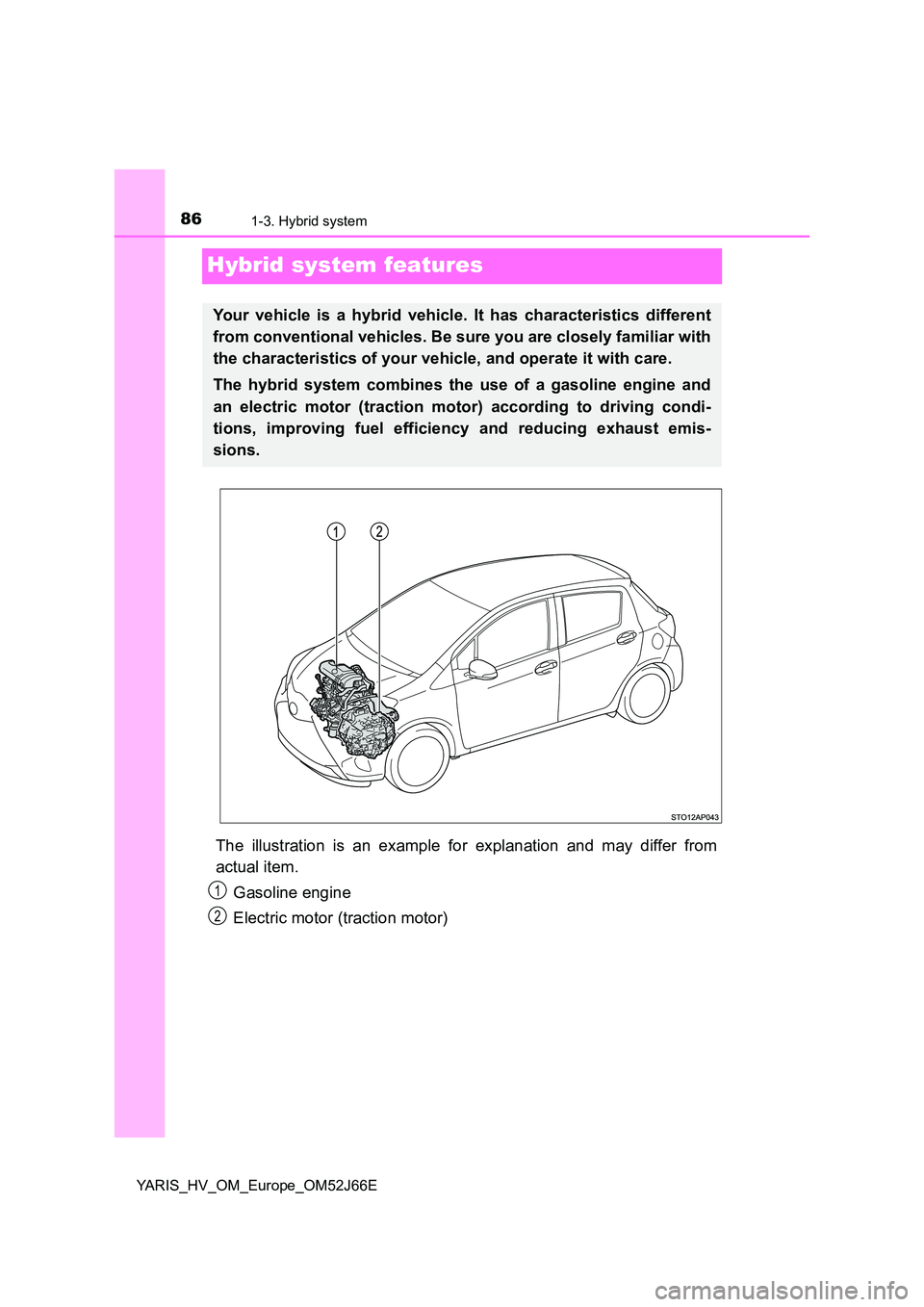
861-3. Hybrid system
YARIS_HV_OM_Europe_OM52J66E
Hybrid system features
The illustration is an example for explanation and may differ from
actual item.
Gasoline engine
Electric motor (traction motor)
Your vehicle is a hybrid vehicle. It has characteristics different
from conventional vehicles. Be sure you are closely familiar with
the characteristics of your vehicle, and operate it with care.
The hybrid system combines the use of a gasoline engine and
an electric motor (traction motor) according to driving condi-
tions, improving fuel efficiency and reducing exhaust emis-
sions.
1
2
Page 87 of 632
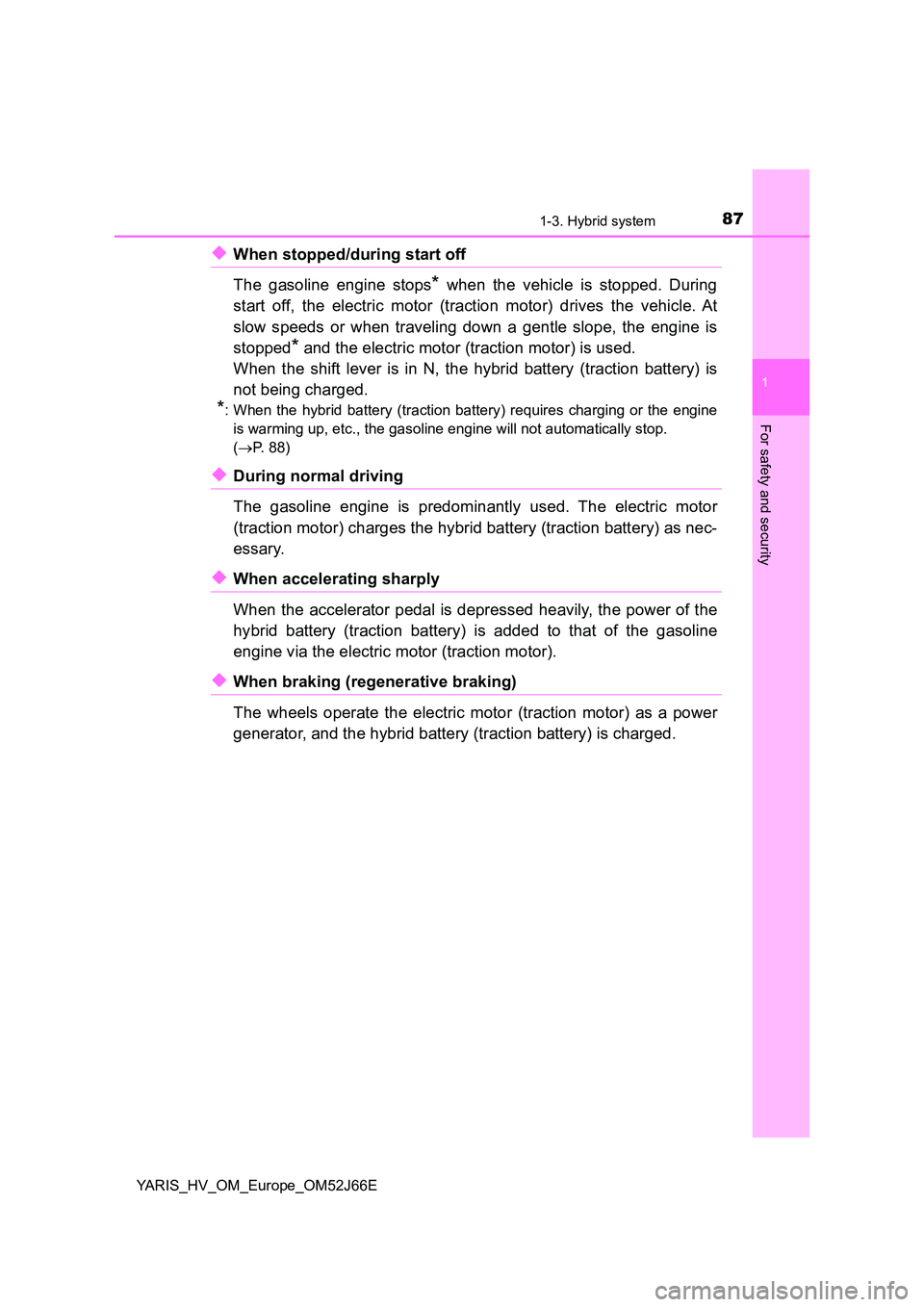
871-3. Hybrid system
1
For safety and security
YARIS_HV_OM_Europe_OM52J66E
◆When stopped/during start off
The gasoline engine stops* when the vehicle is stopped. During
start off, the electric motor (traction motor) drives the vehicle. At
slow speeds or when traveling down a gentle slope, the engine is
stopped* and the electric motor (traction motor) is used.
When the shift lever is in N, the hybrid battery (traction battery) is
not being charged.
*: When the hybrid battery (traction battery) requires charging or the engine
is warming up, etc., the gasoline engine will not automatically stop.
( P. 88)
◆During normal driving
The gasoline engine is predominantly used. The electric motor
(traction motor) charges the hybrid battery (traction battery) as nec-
essary.
◆When accelerating sharply
When the accelerator pedal is depressed heavily, the power of the
hybrid battery (traction battery) is added to that of the gasoline
engine via the electric motor (traction motor).
◆When braking (regenerative braking)
The wheels operate the electric motor (traction motor) as a power
generator, and the hybrid battery (traction battery) is charged.
Page 88 of 632
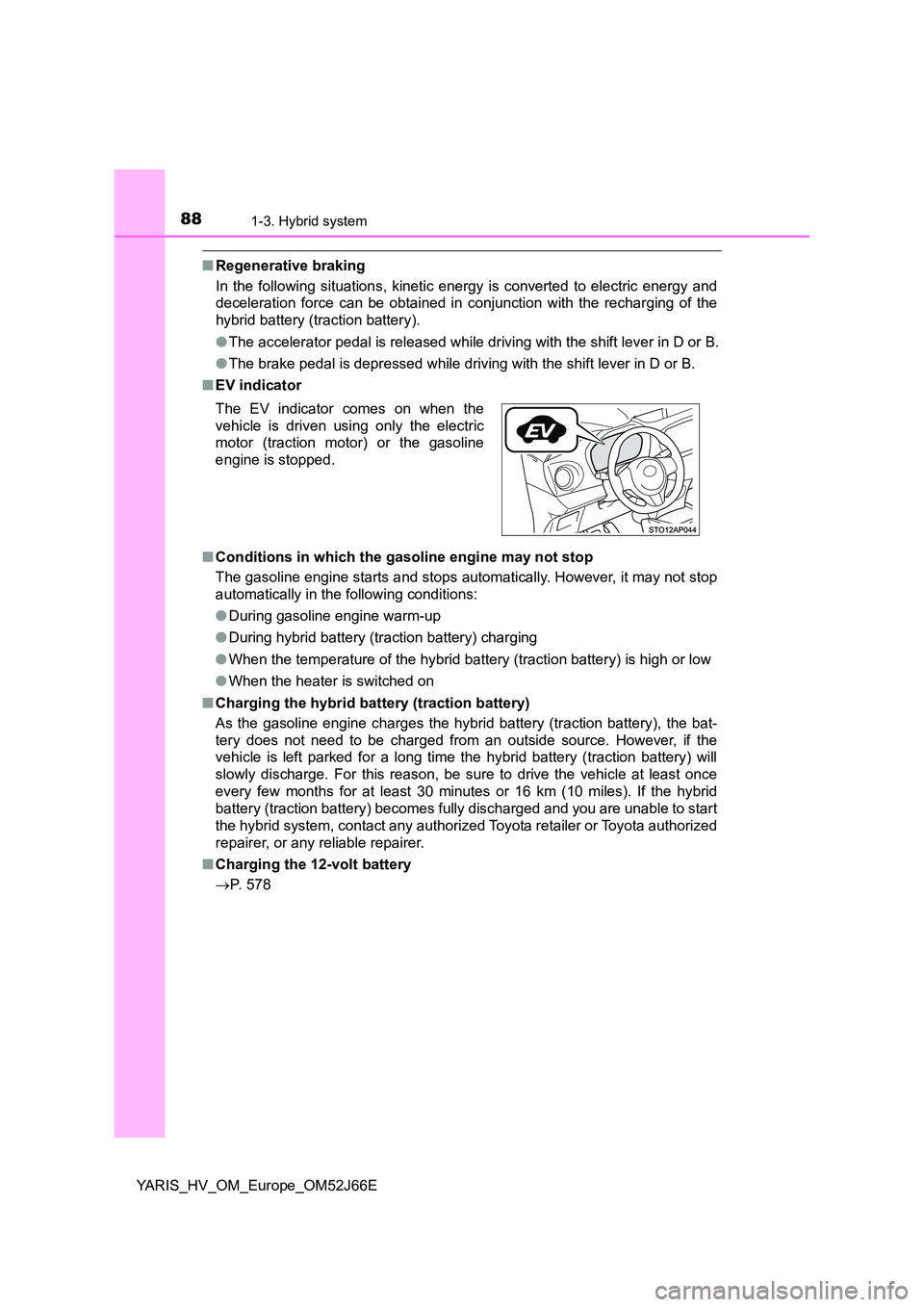
881-3. Hybrid system
YARIS_HV_OM_Europe_OM52J66E
■Regenerative braking
In the following situations, kinetic ener gy is converted to electric energy and
deceleration force can be obtained in c onjunction with the recharging of the
hybrid battery (traction battery).
● The accelerator pedal is released while driving with the shift lever in D or B.
● The brake pedal is depressed while driving with the shift lever in D or B.
■ EV indicator
■ Conditions in which the gasoline engine may not stop
The gasoline engine starts and stops automatically. However, it may not stop
automatically in the following conditions:
● During gasoline engine warm-up
● During hybrid battery (traction battery) charging
● When the temperature of the hybrid battery (traction battery) is high or low
● When the heater is switched on
■ Charging the hybrid battery (traction battery)
As the gasoline engine charges the hybrid battery (traction battery), the bat-
tery does not need to be charged from an outside source. However, if the
vehicle is left parked for a long time the hybrid battery (traction battery) will
slowly discharge. For this reason, be sure to drive the vehicle at least once
every few months for at least 30 minutes or 16 km (10 miles). If the hybrid
battery (traction battery) becomes fully discharged and you are unable to start
the hybrid system, contact any authorized Toyota retailer or Toyota authorized
repairer, or any reliable repairer.
■ Charging the 12-volt battery
P. 578
The EV indicator comes on when the
vehicle is driven using only the electric
motor (traction motor) or the gasoline
engine is stopped.
Page 89 of 632
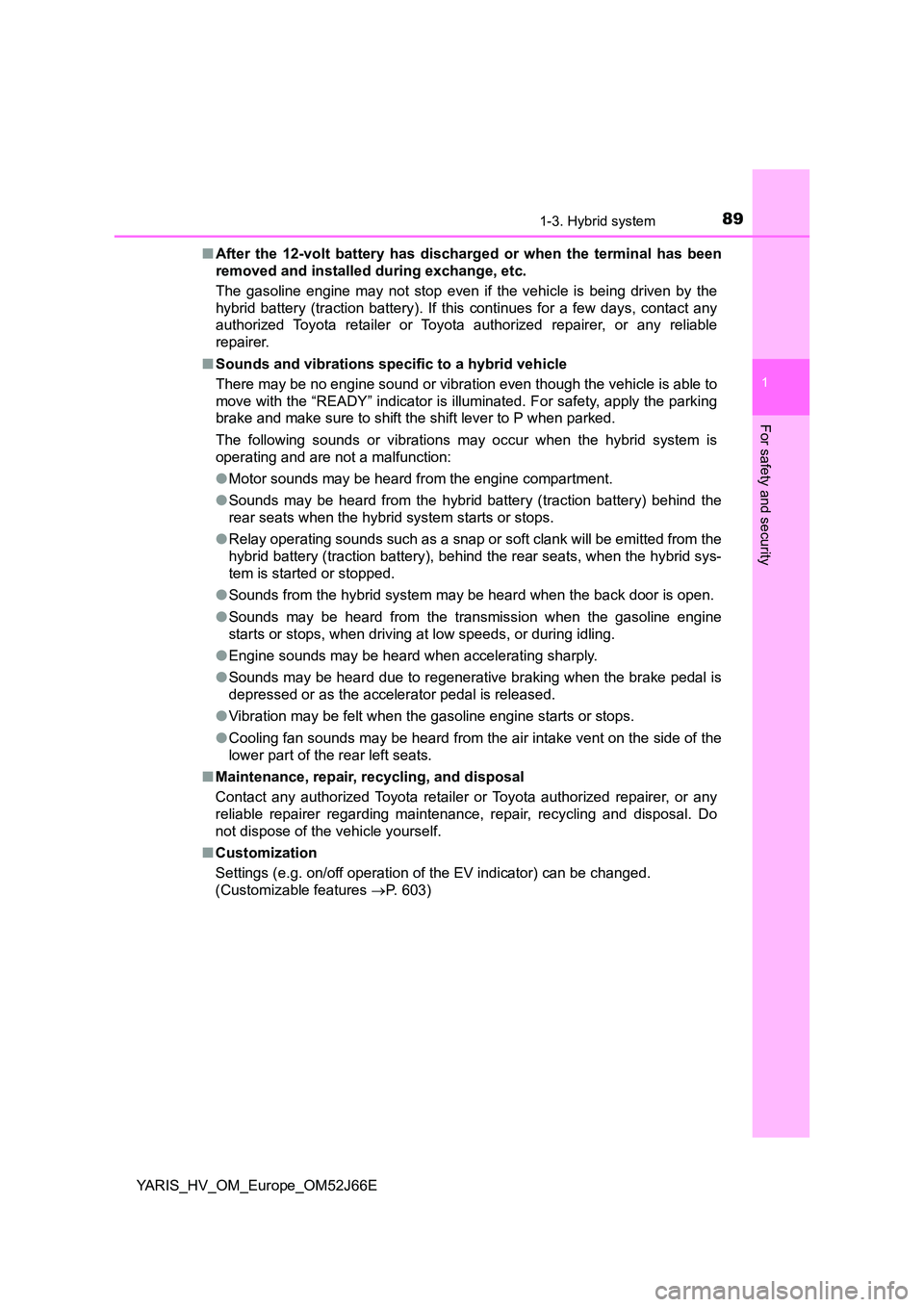
891-3. Hybrid system
1
For safety and security
YARIS_HV_OM_Europe_OM52J66E
■ After the 12-volt battery has discharged or when the terminal has been
removed and installed during exchange, etc.
The gasoline engine may not stop even if the vehicle is being driven by the
hybrid battery (traction battery). If this continues for a few days, contact any
authorized Toyota retailer or Toyota authorized repairer, or any reliable
repairer.
■ Sounds and vibrations specific to a hybrid vehicle
There may be no engine sound or vibration even though the vehicle is able to
move with the “READY” indicator is illuminated. For safety, apply the parking
brake and make sure to shift the shift lever to P when parked.
The following sounds or vibrations may occur when the hybrid system is
operating and are not a malfunction:
● Motor sounds may be heard from the engine compartment.
● Sounds may be heard from the hybrid battery (traction battery) behind the
rear seats when the hybrid system starts or stops.
● Relay operating sounds such as a snap or soft clank will be emitted from the
hybrid battery (traction battery), behind the rear seats, when the hybrid sys-
tem is started or stopped.
● Sounds from the hybrid system may be heard when the back door is open.
● Sounds may be heard from the transmission when the gasoline engine
starts or stops, when driving at low speeds, or during idling.
● Engine sounds may be heard when accelerating sharply.
● Sounds may be heard due to regenerative braking when the brake pedal is
depressed or as the accelerator pedal is released.
● Vibration may be felt when the gasoline engine starts or stops.
● Cooling fan sounds may be heard from the air intake vent on the side of the
lower part of the rear left seats.
■ Maintenance, repair, recycling, and disposal
Contact any authorized Toyota retailer or Toyota authorized repairer, or any
reliable repairer regarding maintenance, repair, recycling and disposal. Do
not dispose of the vehicle yourself.
■ Customization
Settings (e.g. on/off operation of the EV indicator) can be changed.
(Customizable features P. 603)
Page 109 of 632

1092. Instrument cluster
2
Instrument cluster
YARIS_HV_OM_Europe_OM52J66E
Warning lights inform the driver of malfunctions in the indicated vehi-
cle’s systems.
Warning lights
*1
(Red)
Brake system warning
light ( P. 517)
*1
ABS warning light
( P. 519)
*1, 8Charging system
warning light ( P. 517)
*1Electric power steering
system warning light
( P. 519)
*9, 10Charging system
warning light ( P. 517)
*1, 2, 6PCS warning light
( P. 519)
*1, 8Low engine oil pressure
warning light ( P. 518)
*1, 3
Slip indicator (P. 520)
*9, 10
Low engine oil pressure
warning light ( P. 518)
*2, 8
(Yellow)
Automatic High Beam
indicator ( P. 520)
*1, 8High engine coolant
temperature warning
light ( P. 518)
*1
(Yellow)
Brake system warning
light ( P. 520)
*9, 10High engine coolant
temperature warning
light ( P. 518)
*2, 8
(Yellow)
Cruise control indicator
( P. 520)
*1, 8
Hybrid system warning
light ( P. 518)
*2, 8
(Yellow)
LDA indicator (P. 520)
*1
Malfunction indicator
lamp ( P. 518)
*2, 7, 8
(Yellow)
Lane marker indicators
( P. 520)
*1
SRS warning light
( P. 518)
*2, 4, 8
(Yellow)
Smart entry & start
system indicator
( P. 521, 529)
Page 115 of 632
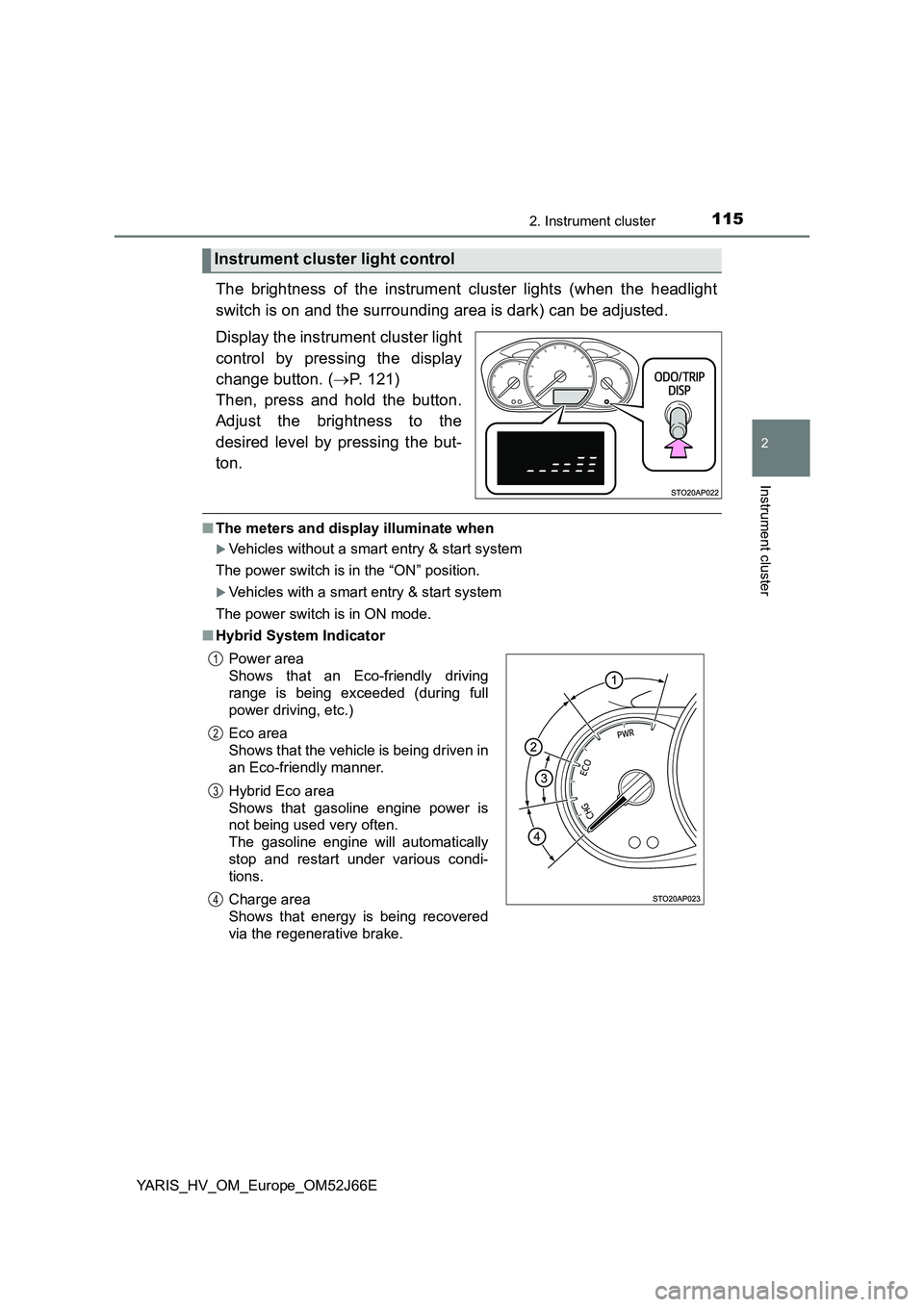
1152. Instrument cluster
2
Instrument cluster
YARIS_HV_OM_Europe_OM52J66E
The brightness of the instrument cluster lights (when the headlight
switch is on and the surrounding area is dark) can be adjusted.
Display the instrument cluster light
control by pressing the display
change button. ( P. 121)
Then, press and hold the button.
Adjust the brightness to the
desired level by pressing the but-
ton.
■ The meters and display illuminate when
Vehicles without a smart entry & start system
The power switch is in the “ON” position.
Vehicles with a smart entry & start system
The power switch is in ON mode.
■ Hybrid System Indicator
Instrument cluster light control
Power area
Shows that an Eco-friendly driving
range is being exceeded (during full
power driving, etc.)
Eco area
Shows that the vehicle is being driven in
an Eco-friendly manner.
Hybrid Eco area
Shows that gasoline engine power is
not being used very often.
The gasoline engine will automatically
stop and restart under various condi-
tions.
Charge area
Shows that energy is being recovered
via the regenerative brake.
1
2
3
4